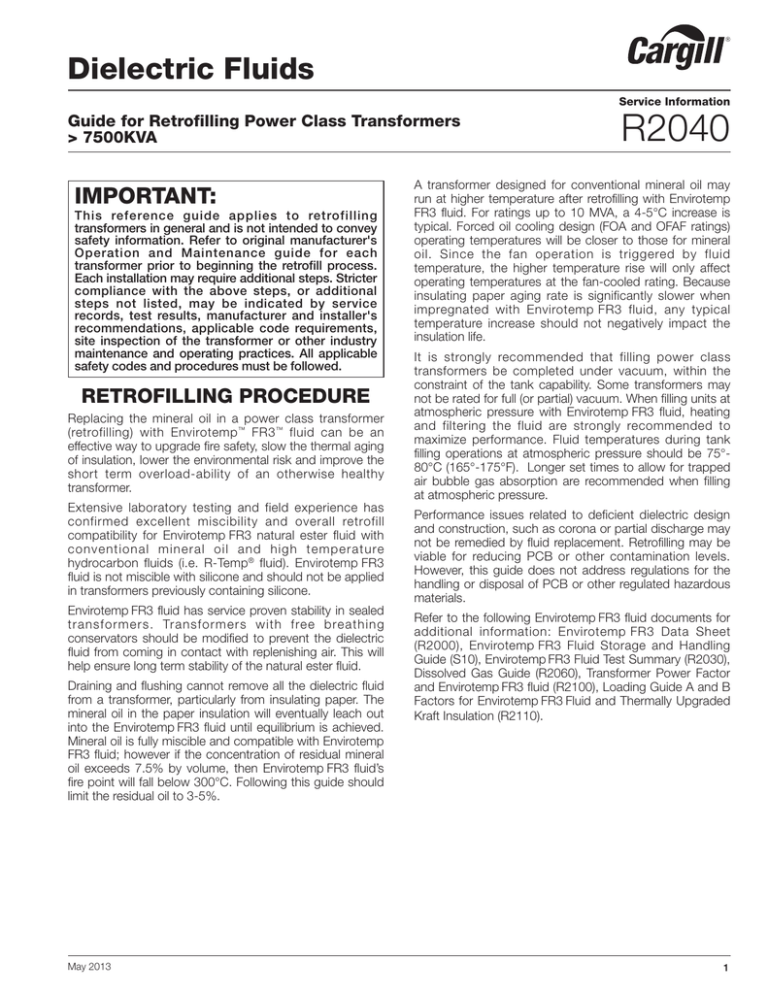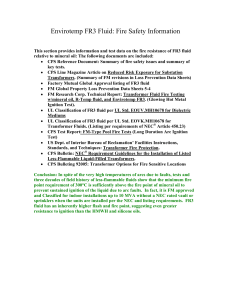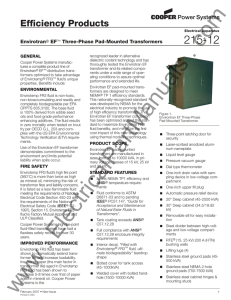
Dielectric Fluids
Service Information
Guide for Retrofilling Power Class Transformers
> 7500KVA
IMPORTANT:
This reference guide applies to retrofilling
transformers in general and is not intended to convey
safety information. Refer to original manufacturer's
Operation and Maintenance guide for each
transformer prior to beginning the retrofill process.
Each installation may require additional steps. Stricter
compliance with the above steps, or additional
steps not listed, may be indicated by service
records, test results, manufacturer and installer's
recommendations, applicable code requirements,
site inspection of the transformer or other industry
maintenance and operating practices. All applicable
safety codes and procedures must be followed.
RETROFILLING PROCEDURE
Replacing the mineral oil in a power class transformer
(retrofilling) with Envirotemp ™ FR3 ™ fluid can be an
effective way to upgrade fire safety, slow the thermal aging
of insulation, lower the environmental risk and improve the
short term overload-ability of an otherwise healthy
transformer.
Extensive laboratory testing and field experience has
confirmed excellent miscibility and overall retrofill
compatibility for Envirotemp FR3 natural ester fluid with
conventional mineral oil and high temperature
hydrocarbon fluids (i.e. R-Temp® fluid). Envirotemp FR3
fluid is not miscible with silicone and should not be applied
in transformers previously containing silicone.
Envirotemp FR3 fluid has service proven stability in sealed
transformers. Transformers with free breathing
conservators should be modified to prevent the dielectric
fluid from coming in contact with replenishing air. This will
help ensure long term stability of the natural ester fluid.
Draining and flushing cannot remove all the dielectric fluid
from a transformer, particularly from insulating paper. The
mineral oil in the paper insulation will eventually leach out
into the Envirotemp FR3 fluid until equilibrium is achieved.
Mineral oil is fully miscible and compatible with Envirotemp
FR3 fluid; however if the concentration of residual mineral
oil exceeds 7.5% by volume, then Envirotemp FR3 fluid’s
fire point will fall below 300°C. Following this guide should
limit the residual oil to 3-5%.
May 2013
R2040
A transformer designed for conventional mineral oil may
run at higher temperature after retrofilling with Envirotemp
FR3 fluid. For ratings up to 10 MVA, a 4-5°C increase is
typical. Forced oil cooling design (FOA and OFAF ratings)
operating temperatures will be closer to those for mineral
oil. Since the fan operation is triggered by fluid
temperature, the higher temperature rise will only affect
operating temperatures at the fan-cooled rating. Because
insulating paper aging rate is significantly slower when
impregnated with Envirotemp FR3 fluid, any typical
temperature increase should not negatively impact the
insulation life.
It is strongly recommended that filling power class
transformers be completed under vacuum, within the
constraint of the tank capability. Some transformers may
not be rated for full (or partial) vacuum. When filling units at
atmospheric pressure with Envirotemp FR3 fluid, heating
and filtering the fluid are strongly recommended to
maximize performance. Fluid temperatures during tank
filling operations at atmospheric pressure should be 75°80°C (165°-175°F). Longer set times to allow for trapped
air bubble gas absorption are recommended when filling
at atmospheric pressure.
Performance issues related to deficient dielectric design
and construction, such as corona or partial discharge may
not be remedied by fluid replacement. Retrofilling may be
viable for reducing PCB or other contamination levels.
However, this guide does not address regulations for the
handling or disposal of PCB or other regulated hazardous
materials.
Refer to the following Envirotemp FR3 fluid documents for
additional information: Envirotemp FR3 Data Sheet
(R2000), Envirotemp FR3 Fluid Storage and Handling
Guide (S10), Envirotemp FR3 Fluid Test Summary (R2030),
Dissolved Gas Guide (R2060), Transformer Power Factor
and Envirotemp FR3 fluid (R2100), Loading Guide A and B
Factors for Envirotemp FR3 Fluid and Thermally Upgraded
Kraft Insulation (R2110).
1
Guide for Retrofilling Power Class Transformers > 7500KVA
TRANSFORMER CONDITION
ASSESSMENT
A visual inspection to confirm integrity of all seals/ bolted
connections, and proper operation of gauges should be
performed. This may indicate whether additional
maintenance operations should be performed while the
unit is out of service.
Pre-Retrofill Steps:
1. Adhere to all safet y precautions, codes and
regulations. Follow all locally approved safety
practices and procedures.
2. Obtain original Operation and Maintenance guide for
each transformer
3. Obtain transformer gasket set
4. Order needed replacement parts
5. Note site limitations for service equipment
6. Schedule old oil disposal
7. Schedule new fluid delivery
8. Obtain container for flush fluid
9. Note location of drain, fill, & vacuum connections
10. Limit air and moisture exposure whenever possible
11. If moisture removal (dry out) of coils is required,
several methods are acceptable, however hot air
drying is not. Refer to Storage and Handling Guide
(S10) for additional information.
2
R2040
Step
1. Adhere to all required safety
precautions, codes, and
regulations
2. Access the unit
Key Points
Follow manufacturer’s recommendations for
servicing each transformer; additionally,
adhere to all required safety precautions,
codes, and regulations
Follow applicable safety precautions and
regulations
Comments
Record all nameplate information and
determine allowable tank vacuum.
Make sure the unit is isolated from the
power system.
3. Ground all equipment
Includes transformer, pump, and tanks
Ensures static discharge
4. Take oil samples
Take samples for fluid analysis and dissolved
gas per ASTM procedures.
Provides a baseline of transformer
condition at the time of retrofill.
5. Drain oil
If transformer is level or tilted towards the
drain plug, force oil out by applying a positive pressure of 5 psig (34 kPa) using dry gas.
Otherwise, pump out oil through drain valve.
Radiators must be completely drained by
removing drain plugs after oil level is below
the lower headers, if upper headers are
not accessible for flushing (see Step 8).
6. Replace all oil-immersed
gaskets
Tighten to proper compression based on
component function and gasket material.
Original gaskets that weep or leak should
be replaced. Elastomers including NBR
types with higher nitrile content, silicone or
fluoropolymer are recommended. Gaskets
with higher temperature demands warrant
the use of silicone or fluoropolymer (Viton)
compositions.
7. Allow minimum ½ hour drip
after draining
8. Flush with hot Envirotemp™
FR3™ fluid ( ≈ 5% of fluid
volume)
Two hours is preferred. Pulling vacuum within
tank mechanical limit will accelerate drip.
A longer drip time is advantageous to
reduce residual mineral oil
Use minimum pressure to avoid dislodging
contaminants. Flush through the fill plug or
bolted access. Be sure to flush radiators. Set
bolted access in place ASAP.
To reduce viscosity, Cargill recommends
flushing fluid temperature between
50-80°C.
9. Allow ½ hour drip
10. Remove dregs from bottom
of transformer
11. Fill Transformer
A longer drip time is advantageous.
Access can be gained by removing drain
valve.
Minimizes the residual mineral oil.
Pull vacuum within tank mechanical limits.
Start fill through drain plug when base pressure is reached.
Minimum 50°C fluid temp. Use 0.5 µm
filters. Limit base pressure to tank rating.
12. Top with dry air or nitrogen
blanket. Bring headspace
pressure to 2-3 psig
(13-20 kPa).
13. Install retrofill label
14. Wait to energize unit
Verify gaskets and seals are working properly
Limits exposure to oxygen and
atmospheric contaminants.
24 hours is preferred. Wait time depends on
fluid fill temperature.
Allows gas bubbles to dissipate.
15. Take oil samples
Check & maintain positive pressure. Take
samples as in 4.
Verifies the unit is leak-free. Provides a
base line for new fluid.
Fill out label using #2 pencil.
16.
a. Energize unit (no load)
b. Wait prior to adding load
c. Connect load
17. Next day, check the
temperature and pressure
18. Follow the standard
maintenance schedule
and procedures
19. Periodically monitor and
record tank pressure to
confirm tank seal.
Three hours minimum.
Observe unit for leaks.
Observe unit for leaks and other signs of
problems.
Pay close attention to signs of leaks from
gaskets. Take samples as in 4 after six
months.
A constant 0 psig (0 kPa) on gauge, despite
temperature changes, indicates a leak.
3
Guide for Retrofilling Power Class Transformers > 7500KVA
9350 Excelsior Crossing Blvd
Hopkins, MN 55343 USA
www.cargill.com/fr3fluid
© 2013 Cargill Incorporated. All Rights Reserved.
4




